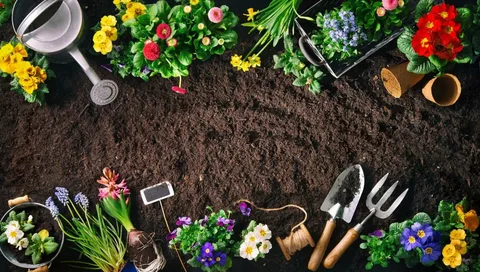Choose perennials with low maintenance needs and bright blooms, such as daylilies and coneflowers. These plants thrive without overwhelming the surrounding greenery and help maintain a flourishing environment year-round.
Implement border techniques to prevent invasion. Using decorative stones or wood will establish clear limits, ensuring flowering plants don’t intrude into the grassy areas, which helps to retain their health.
Consider incorporating container planting as an alternative strategy. Pots featuring seasonal flowers can boost aesthetics without direct contact with the soil. This approach minimizes the risk of damaging the grass while allowing flexibility in arrangement.
Utilize ground covers instead of traditional annuals. Varieties like creeping thyme or clover provide color while enhancing soil quality and protecting underlying roots from heat and drought.
Regularly assess the health of the turf and adjust watering schedules accordingly. Dedicating time to monitor moisture levels helps prevent soft spots where flowers might compete for nutrients and space.
Selecting Plants That Thrive on Grass
Opt for shallow-rooted species such as marigolds and petunias that can coexist with lawns. These varieties won’t heavily compete for nutrients or moisture.
Consider creeping thyme and hawkweed. They spread horizontally, enriching ground cover while not disrupting the need for a healthy sod layer.
Focus on perennials like black-eyed Susans or daylilies. These resilient plants can persist through varying weather conditions, bringing consistent appeal throughout different seasons.
Incorporate ornamental grasses such as fescue or blue oat grass. Their adaptation to diverse environments allows them to harmonize beautifully with traditional grass.
Research native plants; they often require less water and maintenance, leading to a sustainable combination with lawn areas. Species like echinacea and rudbeckia are excellent choices.
Visit resources such as Garden Machinery Hub for further insights and guidance on compatible varieties and landscape techniques that facilitate a thriving space.
Creating a Colorful Flower Bed with Minimal Soil Disturbance
Utilize techniques such as layering and planting in containers to enhance visual appeal without significant disruption to the underlying earth. Employ raised beds filled with lightweight soil mixtures to support diverse blooms while keeping the original grass intact.
Choose perennials that thrive in shallow soils. Varieties like Daylilies, Black-eyed Susans, and Lavender not only flourish but require minimal irrigation once established.
Incorporate innovative planting methods like lasagna gardening. By layering organic materials like cardboard, straw, and compost, you can create a nutrient-rich environment foster growth while protecting the existing turf.
Explore companion planting to maximize diversity. Pairing aromatic herbs with flowering plants deters pests naturally and promotes mutual growth. For instance, blooming Marigolds alongside vegetables not only adds color but also beneficial properties.
For a more controlled approach, consider using modular planting systems. These can be moved, rearranged, and customized without disturbing the grass underneath. Check out platforms like Ultimate Fairway for further information on maintaining lush aesthetics with minimal interference.
Utilizing Container Gardening for a Vibrant Landscape
Opt for container gardening as an innovative tactic to introduce hues without disturbing the grass underneath. Choose lightweight planters that can be easily moved, making it simple to shift arrangements based on seasonal changes or personal preference.
Choosing the Right Containers
Select pots made from materials such as fiberglass or resin for durability and insulation. Terracotta provides a classic look but may require more attention to watering due to its porous nature. Ensure containers have adequate drainage holes to prevent root rot.
Plant Selection and Arrangement
Incorporate a mix of annuals and perennials to create varied textures and colors. Options like petunias, geraniums, or marigolds bring bright blooms, while herbs such as basil and rosemary offer greenery and functionality. Group pots of different heights to add dimension; taller plants in the back will frame shorter ones effectively.
Regularly rotate the plants to maintain freshness throughout the year. Using seasonal arrangements not only keeps the aesthetic lively but also minimizes the strain on the soil and grass below.
Implementing Mulching Techniques to Protect Grass
Utilize organic materials such as wood chips, straw, or shredded leaves as mulch to create a protective layer over soil. This method helps to retain moisture, suppress weeds, and regulate soil temperature, benefiting both flowers and grass. Apply a 2-3 inch layer of mulch around plants while keeping it a few inches away from the grass to avoid suffocating it.
Choosing the Right Mulch
Opt for biodegradable mulches that break down over time and enrich the soil. For instance, hardwood mulch is effective in preventing erosion, whereas straw is lightweight and allows water penetration. Avoid using plastic or rubber mulch, as they can limit air and water movement, potentially harming turf health.
Maintaining Mulched Areas
Regularly monitor the mulch for decomposition and replenish it as needed to maintain an effective barrier. This practice not only enhances the appearance of the space but also nurtures the underlying soil, ensuring the grass remains healthy and robust. Ensure thorough watering of the turf to support healthy growth, especially during the initial stages after mulching.
Scheduling Seasonal Color Changes Without Overcrowding
Rotate plants seasonally to refresh aesthetics while managing space efficiently. Choose a variety of species with staggered bloom times, ensuring ongoing attractiveness throughout the year.
Key Strategies:
- Begin with early bloomers like crocuses and pansies, transitioning to mid-season flowers such as daisies and lilies as the weather warms.
- Incorporate late-blooming options, including asters and chrysanthemums, to extend visual appeal into autumn.
- Utilize a calendar to track planting and harvesting times, coordinating colors to avoid overcrowding at peak periods.
Plant Selection Tips:
- Research native species that thrive in local conditions, ensuring sustainability and robust growth.
- Limit the number of different varieties in a single area, focusing on complementary colors that enhance each other.
- Adopt a design principle of repetition with select plants to create rhythm, allowing space for grass and minimizing invasive competition.
This structured approach allows continual seasonal updates while ensuring the health and vitality of grassy areas.
Q&A:
What are some non-invasive methods to add color to my garden without harming the grass?
There are several ways to enhance the color in your garden without damaging your turf. One approach is to use annuals or perennials in pots. These can be placed strategically in your garden to introduce bursts of color without disturbing the existing grass. Additionally, you can create colorful borders using fabric or garden edging that makes it easy to spot and maintain vibrant flowers while protecting your turf. Incorporating colorful mulch or stones can also contribute to visual appeal while ensuring the grass remains intact.
How can I choose the right flowers to complement my lawn without causing damage to the grass?
Choosing the right flowers involves selecting varieties that thrive in the same conditions as your lawn. Look for flowers that require similar sunlight and water conditions as your grass. Opt for shallow-rooted plants to avoid competition with the turf’s root system. Flowers that can be planted in containers can also be moved around easily, thereby preventing any long-term damage to your grass. Additionally, consider using organic fertilizers and pest control methods to maintain the health of both your flowers and the lawn. This way, you can enjoy a colorful garden without compromising the integrity of your turf.


